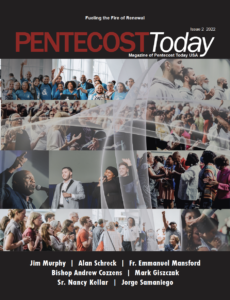In the Malines Documents, you have a guide, a reliable path to keep you from going astray.
Malines Documents Links with brief descriptions
(Descriptions below are taken from a workshop presented by Fr. Wilfried Brieven, longtime secretary to Cardinal Leon Jozef Suenens, on the occasion of the Golden Jubilee of the Renewal, 2017)
Malines 1: Theological and Pastoral Orientations on the Catholic Charismatic Renewal
1974 – Looking at the ecclesiastical context of the Renewal as well as the theological basis; also considered are areas of theological concern, especially about the use of the words ‘baptism in the Holy Spirit’. This also evaluated, in a positive way, pastoral orientations about charisms and ecumenical dimensions.
Malines 2: Ecumenism and Charismatic Renewal
1978 – The document aimed to show what specific contribution the Charismatic Renewal can make to the ecumenical movement, which is endeavoring to reunite divided Christians. The conditions for authentic ecumenism and authentic Charismatic Renewal and the links between those are examined as well as giving . He gives concrete pastoral guidelines and opens horizons when he evokes spiritual ecumenism.
Malines 3: Charismatic Renewal and Social Action: A Dialogue By Card. Suenens and Bishop Dom Helder Camara
1979 – They both show in a complementary way to Christians that prayer evangelization, social and political action can and must be integrated in the life of a Christian, guided by the Holy Spirit. They see the tensions between the ‘spiritual’ man and the ‘active’ man. How to avoid that the Charismatic Renewal be alienated from the ‘real’ world is one of their concerns.
Malines 4: Renewal and the Powers of Darkness
1982 – Cardinal Ratzinger, then the prefect of the Congregation of Faith, wrote the preface. The subject of the document was very delicate. The cardinal was aware that there were excesses in the practice of exorcism in some places within the Renewal. He said that he wrote it with tears, knowing that some people objected that he was speaking of myths that didn’t exist, and at the other hand, that others who practiced at a wide scale prayers for liberation of the devil, said that he lacked pastoral experience.
Malines 5: Nature and Grace, A Vital Unity
1985 – He examined, reacting to some pedagogical excesses, that in the actual world there is a hypertrophy of the individual person and that the role of grace is minimalized. Some psychological methods insist too much on autoanalysis and promote narcissism. In the education of the Christian we may not ignore that the human being, rich in natural gifts, is also fragile and wounded. The modern man may never forget that grace is an essential part of his healing and his growth.
Malines 6: Resting in the Spirit
1986 – The phenomenon was very controversial in that period and divided the spirits in the Renewal. The cardinal contacted ICCRO that later became ICCRS to gather reactions in the whole world. He received many answers that went all ways. He examined the phenomenon and his conclusion at that moment was very restrictive. It shows that the cardinal remained always attentive at what was happening within the Charismatic Renewal and that he took seriously the mandate he received from pope Paul VI to be the guardian that the Catholic Charismatic Renewal always remained in the heart of the Church.
(A complete list of the writings of Cardinal Suenens, including his book “A New Pentecost?“, can be found HERE thanks to the Cardinal Suenens Center at John Carroll University).
Beginnings:
“From the 21st till the 26th of May 1974 [Cardinal Suenens] brought together, at the Archbishop’s house in Malines, 8 theologians and leaders of the Renewal: Fr. Carlos Aldunate from Chile, Fr. Salvador Carrillo from Mexico, Ralph Martin from the U.S., Fr. Albert de Montleon, (later bishop), from France, Fr. Kilian Mc Donnell from the U.S (who wrote the first draft and had the responsibility of formulating the final text), Heribert Mühlen from Germany, Veronica O’Brien from Ireland and
Kevin Ranaghan from the U.S.
There were also six theologians who didn’t attend the meeting but were consulted. Among them Fr. Joseph Ratzinger, (who became pope Benedict XVI) and Fr. Walter Kasper (who became cardinal).”
From “The Legacy of the Malines Documents” workshop
2017 Golden Jubilee of the Renewal, Rome

 Click Here for us to pray for your intentions through our new website.
Click Here for us to pray for your intentions through our new website. 
